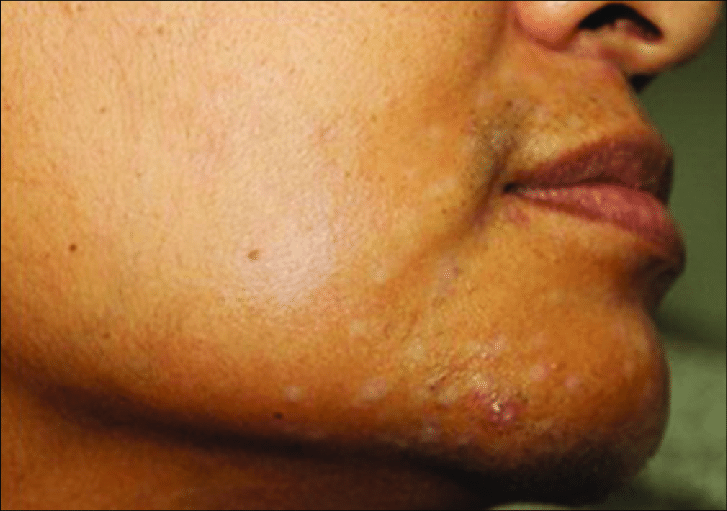Laser hair removal is a great option for those looking to get rid of unwanted hair, but there’s something you might not know—it can cause hypopigmentation.
What is hypopigmentation? It’s when the skin loses its natural pigment, leaving it lighter and whiter than before. While this can happen anywhere on your body, it’s most common around areas where you’ve had laser hair removal.
How do I know if I have hypopigmentation? If you’re noticing patches of skin that are lighter than the rest of your body, or if your skin has lost some of its natural color, then it’s possible that you have hypopigmentation.
This condition affects people in different ways; some experience only mild discoloration while others end up with large patches of whitened skin that don’t go away. The severity depends on how much laser energy was used during treatment, as well as how long ago treatments were conducted.
If you think that you may be experiencing hypopigmentation after laser hair removal, consult with a dermatologist who can advise on treatment options for this condition.

In this article we’ll also consider hypopigmentation treatment and white spots after laser treatment.
Not long ago, I had a reader call about treating light spots on her face. She got them after a laser treatment. When your skin loses color like hers did, it’s called hypopigmentation. It often happens after laser treatments that target one specific color – called a chromophore. Lasers that work this way are very good at removing dark spots, tattoos or hair; but in some cases they work too well. The dark spot, hair, or tattoo is removed, but so is all of the pigment in the treated area. Only a light spot remains.
The people most frequently affected have dark skin and have had multiple treatments. Usually their color loss is temporary, but for some it is permanent. This also happens in people who have skin resurfacing treatments where the entire top layer of skin is removed.
So now you know that hypopigmentation is a light spot in skin caused by low amounts of melanin. (Melanin is what gives skin its color.) But there are other causes of color loss besides lasers.
Diseases (like Vitiligo, Seborrheic dermatitis, or Tinea versicolor) can cause light spots. And skin injuries (like infections, pimples, blisters, or scrapes), burns, or any kind of trauma can also cause hypopigmentation. When an injury causes inflammation and damage leading to color loss, it is called post-inflammatory hypopigmentation, or PIH.
So what can you do about light spots and hypopigmentation?
Treating hypopigmentation is tricky. If you get light spots that don’t go away, be sure to see a dermatologist. The best treatment option will depend on what’s causing your hypopigmentation, the amount of light skin you have, and the result you want to achieve.
There are many treatments for hyperpigmentation. There aren’t nearly so many for hypopigmentation.
1. If you have post inflammatory hypopigmentation from a skin injury or skin rejuvenation procedure, you may want to wait before seeking treatment. When the cause of the post postinflammatory hypopigmentation is removed, most people get spontaneous improvement within a period of weeks or months. But if the melanocytes (that give skin color) are destroyed, the color loss will be permanent. Post inflammatory hypopigmentation is treated with steroid creams, light or laser treatments, and skin grafting.
2. Prescription medications can help to repigment light spots. Puvasol, topical psoralen, and UV light from sunlight or UVA phototherapy may help especially in people whose color loss was from a laser treatment. V-Tar is another prescription your doctor may order. It is a coal tar topical medication that has worked well for people with vitiligo.
3. Low-level laser (light) therapy (LLLT) is used to treat many skin conditions. It can kick start healing, relieve pain and inflammation, and restore function. It can also stimulate your pigment producing cells (melanocytes) to produce melanin thereby re-pigmenting light spots and areas of hypopigmentation.
4. If you have light spots caused by a skin disorder like vitiligo, (shown above right) the treatment usually includes prescription medications. Vitiligo is an autoimmune disorder that causes white patches of skin. People with vitiligo get hypopigmentation because their white blood cells attack and kill the cells which give their skin color. When these melanocytes are destroyed, they don’t come back. So people with light spots over more than half of their body may want their dark spots lightened to match the rest of their body. In cases like this doctors use skin lighteners like hydroquinone or Tri-Luma. Some people with vitiligo also get improvement with a drug called Psoralen combined with light therapy.
5. IPL, excimer lasers, and the Fraxel Restore laser are all recommended for treating hypopigmentation by the doctors on RealSelf.com.
- IPL stands for intense pulsed light. You may also have heard it called a photofacial, BBL (broadband light), or photorejuvenation. It treats sun damage, dark spots and rosacea. This kind of light treatment targets brown and red chromophores. For people with greater than half of their skin affected by hypopigmentation, using IPL to treat the melanin in unaffected skin can create a more even skin tone.
- The 308-nm excimer laser was studied in the treatment of white stretch marks and scars that had lost melanin. Patients were treated every 2 weeks for a maximum of 10 treatments. Each patient achieved a 100% correction to the eye and a 75% increase by colorimetric measurement (The amount of light absorbed as it travels through a sample.) BUT maintenance treatments were required every 1 – 4 months to retain the color. This study was published in the Archives of Dermatology Journal in 2004.
- Another study published in Dermatologic Surgery in 2007, was done on hypopigmented scars on the faces of 7 patients. A 1550-nm Fraxel laser was used to treat all 7 patients. 6 out of 7 got a 51 – 75% improvement in color after 2 – 4 treatments spaced every 4 weeks. The last patient measured at a 26 – 50% improvement. Fractional resurfacing also evens skin tone with a mixture of hypo and hyperpigmentation.

6. Micro-Needling works to reduce scars and hypopigmentation. This method uses needles to pierce the skin without removing tissue. Your body reacts to these micro-injuries by forming new collagen and elastin. Our bodies won’t replace the scar tissue completely, especially if the scar is deep; but they will replace the parts that are injured by micro-needling. This creates a mixture of scar tissue and normal tissue and results in a smoother, better looking, softer scar. Indented scars fill and raised scars flatten. Needling a hypo-pigmented scar will also cause your pigment producing cells to move from the surrounding skin into the scar, improving its color. Learn more on our Scars and Stretch Marks page.
7. If none of these work, some doctors will recommend skin grafting or blister grafting. Blister grafting is a great option because there is no scarring. During this procedure, your doctor creates a blister on an part of your skin with normal color. Then he or she removes the top of the blister and reattaches it to the area without pigment.
8. Another interesting option is being researched. It treats light spots and hypopigmentation using bimatoprost ophthalmic solution 0.03% (also know as Latisse and Lumigan) in combination with the Fraxel laser and topical retin-A. Bimatoprost increases pigment production, while the Fraxel and retin-A allow the bimatoprost to better penetrate the skin. There are a few studies, but more research is needed.
- A study was done on 5 patients with long term hypopigmentation. All were treated with 1 – 4 sessions of the Fraxel re:store followed by twice daily application of bimatoprost and evening application of retin-A .025% cream. Each patient was evaluated in 1 – 6 month intervals and each was compared to pictures taken before treatment. “All five patients uniformly demonstrated clinically significant repigmentation, and they responded almost immediately,” explained the study’s author, Dr. Richard Fitzpatrick, M.D., Director of Cosmetic Dermatology at La Jolla Cosmetic Surgery Centre in La Jolla, CA, and Volunteer Clinical Professor at University of California San Diego.
- Unfortunately, there was no study of the long term effects; but Dr. Fitzpatrick says that, in his own patients, the results were maintained over a long period of time. One patient’s results even lasted about 3 years.
- Another study by Massaki et al. combined fractional laser treatments with topical bimatoprost, a PGA (a hydrating ingredient), and tretinoin (like retin-A) or pimecrolimus (a topical immunosuppressant). There was a greater than 50% improvement in over 85% of the patients treated.
- Bimatoprost is considered a very safe drug as well. As you know, Latisse is used to grow eyelashes so some people may worry about hair growth. Dr. Fitzpatrick says that when bimatopost is used on scar tissue, this should not be a concern. Because scar tissue doesn’t have hair follicles, there is a very low chance of hair growth.
9. Finally, if the hypopigmentation does not improve with medications or treatments, camouflaging with makeup, cosmetic tattooing or permanent makeup are good options.
- Airbrush makeup is typically used to cover large or small areas with hypopigmentation or hyperpigmentation. Learn more in our article, How Airbrush Makeup Covers Tattoos, Acne, Vitiligo, Etc.
- Tattoos can be used to cover light spots. The tattoo artist uses a pigment that matches the color of your surrounding skin to make the light spots barely noticeable. It’s called cosmetic tattooing, permanent makeup, or paramedical tattooing. Check out Basma Hameed on YouTube. She is amazing!
- Dermablend makeup was created by a dermatologist and his makeup artist wife to solve the complexion problems that skincare could not.
You’ll probably need a couple of different types of treatments to minimize your hypopigmentation.
None of the methods work perfectly, so you’ll need to work with your provider to find what will work best for you. Initially, you may have had dark spots removed, which in turn caused light spots. The next best step is to find a method that will blend the dark and light spots – as they’re often a package deal. Sorry to tell you! And be sure to wear sunscreen to prevent more problems! Good luck!
Hypopigmentation Treatment
Hypopigmentation treatment depends on what caused your skin to lighten.
If you have hypopigmentation from injuries to your skin or skin treatment, you likely won’t need treatment. Your skin cells will start to make melanin again as your affected areas heal. Hypopigmentation will usually go away after a few weeks or months.
If you have pityriasis alba, psoriasis or eczema, hypopigmentation usually goes away on its own without treatment. It may take a few weeks or months.
If hypopigmentation is a symptom of a skin condition, certain medications can treat it. These medications may include corticosteroids and topical calcineurin inhibitors, including tacrolimus ointment and pimecrolimus cream.
Phototherapy is effective if you have hypopigmentation from laser treatments (laser-induced hypopigmentation). These treatments include laser hair removal, laser tattoo removal or laser skin resurfacing. It uses ultraviolet (UV) light from special lamps. Your healthcare provider may use a drug called psoralen combined with ultraviolet A (PUVA) or ultraviolet B (UVB). Studies suggest that phototherapy helps treat laser-induced hypopigmentation in skin of color.
There aren’t any effective treatments for albinism or scars that have hyperpigmentation.
White Spots After Laser Treatment
Milia, which are small, white bumps, may appear in the laser-treated areas during healing (up to a month after treatment). These may be removed by gentle cleansing with a washcloth.
Hyperpigmentation, and more rarely, hypopigmentation, may result in the laser-treated areas. In general, the hyperpigmented areas may be treated with bleaching cream to speed fading of the pigment. In addition, you should use broad-spectrum sunscreens for weeks before and after the treatment to prevent pigmentary changes.
